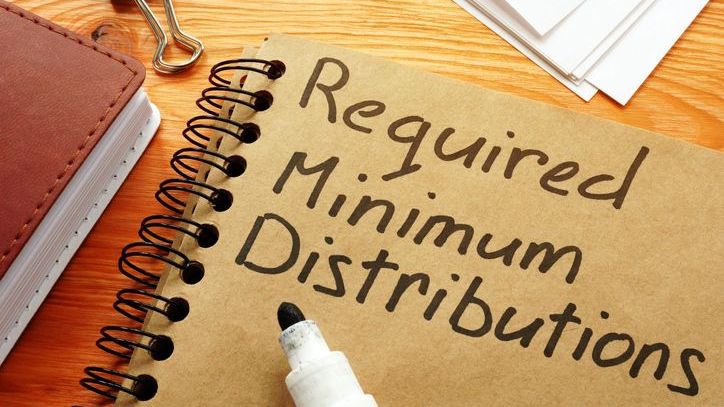You may not be thinking about required minimum distributions (RMDs) throughout your career, but chances are that they’ll be on your mind once you hit your 70s.
RMDs are a critical part of retirement planning. A financial advisor can help you prepare for these mandatory withdrawals, which can have a significant impact on your taxes.
The IRS requires you to begin taking annual withdrawals from traditional IRAs, 401(k)s and other tax-deferred retirement accounts. When you must take your first RMD depends on your age. While RMDs currently begin at age 73, that won’t always be the case. Under the SECURE 2.0 Act, the RMD age is set to increase to 75 in 2033.
About the RMD Age

On the face of it, the mechanics of RMDs are simple: The account holder takes out a certain percentage of the tax-deferred money based on their account balances at the end of the previous year. That amount is divided by the account holder’s life expectancy factor – a number computed by the IRS – to produce the RMD amount.
For example, the IRS expected distribution period for a 74-year-old person is 25.5. If their IRA balance was $200,000 on Dec. 31 of the previous year, their RMD amount would be $7,843.
That’s just simple math. When you’re required to take your first RMD, on the other hand, is a little more complicated:
- Those born before July 1, 1949, had to take their first RMD at age 70 ½, which means those folks should already be taking distributions.
- Those born between July 1, 1949 and 1950 had to start their RMDs at age 72, and also should have already done so.
- Anyone born between 1951 and 1959 must take their first RMD by April 1 of the year after they turn 73.
- Anyone born in 1960 or later must take their first RMD by April 1 of the year after they turn 75.
As you can see, the IRS allows you to postpone your first RMD until April 1 of the year after you are required to begin distributions. For anyone born in 1952, their RMDs start this year but they can wait until April 1, 2026, to make the actual withdrawal. After that, each annual withdrawal needs to happen before the end of the year, which means anyone who postpones their first RMD in 2025 will need to make a second withdrawal before the end of 2026.
Keep in mind that a financial advisor can help you build a comprehensive retirement plan, accounting for RMDs as part of it.
Should You Postpone Your First RMD?

This raises the question of whether it’s better to postpone your first RMD. In some cases, it can make sense. If your spouse is still working but plans to retire next year, postponing the first RMD means you might be in a lower tax bracket by April 1 of the following year.
The downside of postponing the first RMD is that taking two distributions in the same year could push you into a higher tax bracket. Two RMDs will also likely increase your combined income and potentially lead to taxes on 85% of your Social Security benefits. A higher income also could increase your Medicare premiums, which are subject to an income-related monthly adjustment amount (IRMAA) surcharge.
Enter your age and balance to see your required distribution for the coming year.
Required Minimum Distribution (RMD) Calculator
Estimate your next RMD using your age, balance and expected returns.
RMD Amount for IRA(s)
RMD Amount for 401(k) #1
RMD Amount for 401(k) #2
About This Calculator
This calculator estimates RMDs by dividing the user's prior year's Dec. 31 account balance by the IRS Distribution Period based on their age. Users can enter their birth year, prior-year balances and an expected annual return to estimate the timing and amount of future RMDs.
For IRAs (excluding Roth IRAs), users may combine balances and take the total RMD from one or more accounts. For 401(k)s and similar workplace plans*, RMDs must be calculated and taken separately from each account, so balances should be entered individually.
*The IRS allows those with multiple 403(b) accounts to aggregate their balances and split their RMDs across these accounts.
Assumptions
This calculator assumes users have an RMD age of either 73 or 75. Users born between 1951 and 1959 are required to take their first RMD by April 1 of the year following their 73rd birthday. Users born in 1960 and later must take their first RMD by April 1 of the year following their 75th birthday.
This calculator uses the IRS Uniform Lifetime Table to estimate RMDs. This table generally applies to account owners age 73 or older whose spouse is either less than 10 years younger or not their sole primary beneficiary.
However, if a user's spouse is more than 10 years younger and is their sole primary beneficiary, the IRS Joint and Last Survivor Expectancy Table must be used instead. Likewise, if the user is the beneficiary of an inherited IRA or retirement account, RMDs must be calculated using the IRS Single Life Expectancy Table. In these cases, users will need to calculate their RMD manually or consult a finance professional.
For users already required to take an RMD for the current year, the calculator uses their account balance as of December 31 of the previous year to compute the RMD. For users who haven't yet reached RMD age, the calculator applies their expected annual rate of return to that same prior-year-end balance to project future balances, which are then used to estimate RMDs.
This RMD calculator uses the IRS Uniform Lifetime Table, but certain users may need to use a different IRS table depending on their beneficiary designation or marital status. It's the user's responsibility to confirm which table applies to their situation, and tables may be subject to change.
Actual results may vary based on individual circumstances, future account performance and changes in tax laws or IRS regulations. Estimates provided by this calculator do not guarantee future distribution amounts or account balances. Past performance is not indicative of future results.
SmartAsset.com does not provide legal, tax, accounting or financial advice (except for referring users to third-party advisers registered or chartered as fiduciaries ("Adviser(s)") with a regulatory body in the United States). Articles, opinions and tools are for general informational purposes only and are not intended to provide specific advice or recommendations for any individual. Users should consult their accountant, tax advisor or legal professional to address their particular situation.
However, if you’re going to make a qualified charitable distribution (QCD) with your RMD, you won’t pay any tax on the withdrawal. As a result, you can postpone your first distribution, leaving the money to generate additional gains until you donate it to a charity. And if you end up needing your second RMD for income, you won’t have to deal with the tax impact of two RMDs in one year since your QCD would have been made tax-free.
Whatever your strategy for taking RMDs, it’s important to meet the deadlines. If you don’t take an RMD, you’ll be penalized with a 25% tax on the required amount you didn’t withdraw (which drops to 10% if it is corrected within two years). If that sounds harsh, just remember that the penalty tax was 50% until the SECURE 2.0 Act was signed in 2022. A financial advisor can help you plan out your RMDs so you can anticipate their tax impact.
Bottom Line
The age to start taking required minimum distributions has changed for many people but you still have the option to postpone your first RMD until April 1 of the year after you’re required to start making withdrawals. Doing so can have either positive or negative tax consequences depending on your broader financial circumstances.
Tips for Managing Your RMDs
- A financial advisor can help you plan for RMDs and potentially limit their impact. Finding a financial advisor doesn’t have to be hard. SmartAsset’s free tool matches you with vetted financial advisors who serve your area, and you can have a free introductory call with your advisor matches to decide which one you feel is right for you. If you’re ready to find an advisor who can help you achieve your financial goals, get started now.
- If you’re unsure how much you’ll be required to withdraw, SmartAsset has a special RMD calculator designed specifically to help you estimate how much your mandatory distributions should be.
Photo credit: ©iStock.com/designed491, ©iStock.com/shapecharge, ©iStock.com/katleho Seisa
